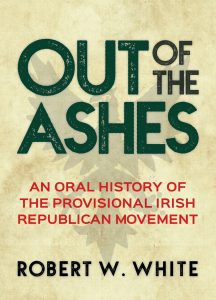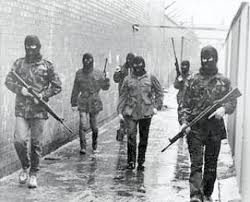Book Review: Out of the Ashes, an oral history of the Provisional Irish Republican Movement
 By Robert W. White
By Robert W. White
Published by Merrion Press, 2017.
Reviewer: John Dorney
Robert White is an American sociologist, who over 30 years conducted a series of interviews with members of Sinn Fein and the Provisional IRA.
There are some interesting things in this book; the interviews with the veterans of the IRA campaigns of the 1940s and 50s are illuminating. There is interesting material on the 1975 IRA ceasefire and on the 1990s peace process. The Republican movement’s various splits are analysed in terms of generation, geography and experience as well as ideology, which is an interesting and informative approach.
The final chapter provides some detail on the splintering into micro-groups of those Republicans who attempted to maintain the ‘armed struggle’ in the 21st century.
And yet, overall, this book is a disappointment. The first problem is perhaps not entirely of the author’s making. This work purports to be an ‘oral history of the Provisional Republican Movement’ but the inside access this would require simply is not there. The author conducted a series of interviews in 1985, 1995 and 2005 with Republican activists, a category that included Sinn Fein members, former IRA prisoners and others .
The problem is that, unlike the remarkably rich sources we now have for the revolutionary period of the 1920s, such as the Bureau of Military History and the Military Pension collection, his respondents were not willing to talk about the central tenet of Provisional Republicanism, that is the use of the force or ‘armed struggle’. Publication of such information in the 1980s would of course have been extremely dangerous for respondents.
What is more, the fiasco of the Boston College tapes, where interviews with paramilitaries that were collected by journalist Ed Moloney were later subpoenaed by the Police Service of Northern Ireland for investigations into unsolved murders, has meant that no one is likely to open up to researchers again for the foreseeable future.
So instead of an inside look into the Provisional IRA, which waged a nearly thirty-year long campaign of political violence in Northern Ireland, what we get instead is a rather vague collection of attitudes from a medley of activists from both sides of the border, mostly Sinn Fein or anti-H Block activists with a few ex-prisoners who talk a little about their times in the IRA in the early 1970s.

The author appears not to appreciate the vast gulf separating the experiences of southern Republicans from those inside the ‘war zone’ in Northern Ireland or the drastically different experiences of serving as a Sinn Fein councillor and serving in a Provisional IRA active service unit. Rather, all of these categories of activist tend to be lumped in together as representatives of the ‘Republican Movement’.
Furthermore, there are simply not enough of them to make this a really coherent oral history of the Provisional movement. So instead, much of the text is actually a fairly conventional narrative history of the Troubles from a Republican point of view. There is nothing wrong with this, but not much new either.
While it is understandable that the author could not get respondents to talk about illegal activities, it is frustrating that he did not mine those first hand sources we do have a bit more thoroughly. Eamon Collins’ memoir for instance, ‘Killing Rage’ explains exactly how a P.IRA active service unit worked in the early 1980s but also how Collins, at one time a hardline militarist, grappled with his frustration at the leadership’s increasingly political strategy, before eventually breaking under interrogation and becoming an informer.
Similarly Rogelio Alonso’s admittedly antagonistic ‘The IRA and Armed Struggle’ was able to get IRA members to discuss much more openly the debates within the movement over the use of force in the 1980s and 1990s. Neither of these sources or other comparable ones appear to have been used here.
If access to inside information is one problem, then the author’s apparent closeness to some of his respondents is another. A particularly sympathetic hearing is given to Ruairi O Bradaigh and other founders of the Provisional IRA and Sinn Fein in 1970, who later split again from the Provisional movement in 1985 and later opposed the Good Friday Agreement of 1998.
Regarding the initial split in the IRA and Sinn Fein in 1969-70, when the Provisional movement was formed, White basically gives unchallenged the Provisionals’ version that the existing IRA leadership failed to protect the Catholic nationalist community from a loyalist pogrom and the Provisional IRA arose ‘out of the ashes’ of burned-out Bombay Street. The IRA, in this version were being called ‘I Ran Away’ in Catholic neighbourhoods of Belfast before the Provisionals restored their reputation in the Catholic ghettos.
The problem is that, as Brian Hanley for one has shown, the existing leadership, pre-1969, of what became known as the Official IRA did in fact mount an armed defence of Catholic neighbourhoods as best they could in the rioting of August 1969. Hanley has been at pains to point out that there is actually no evidence of ‘I Ran Away’ being scrawled on Belfast walls at the time.
On top of that, there is a wider point that is central to the whole history of the Provisionals. White writes that it was not Republicans or the Catholic Civil Rights movement that sparked off the Northern Ireland conflict but British mismanagement of the crisis. Now clearly this is true to an extent, British Army incursions onto the Falls Road, the introduction of one-sided internment in 1971 and Bloody Sunday in Derry in 1972 all conspired to create mass support for armed struggle among Northern Catholics.
What this narrative fails to acknowledge though is that the Provisional IRA was itself partly driving these events by its insistence that the only strategy could be armed struggle against British forces until Britain left Northern Ireland. The book never once seems to consider whether this was in fact the right strategy of whether it was actually a blind alley.
What if no amount of force would change the status of Northern Ireland while the majority there was unionist? What if more political violence actually drove the conflict, provoking greater state and loyalist violence and creating a vicious circle of attack and retaliation? What if Northern Catholics’ very real grievances could be remedied without a united Ireland in the short term?
These hard questions never seem to be raised with the author’s interviewees. Nor is due weight given to the Republicans’ attitudes towards loyalist and unionism.
The Official Republicans, who later became the Workers Party, argued that Northern Ireland must first be ‘democratised’ and the sectarian barrier overcome by class politics before Irish unity could be achieved. The moderate SDLP argued that what was needed was a reconciliation between nationalists and unionists within Northern Ireland. Both of these points of view are blithely dismissed here and there seems to be a degree of sympathy for those Republicans who feel betrayed by the Provisional leadership of Gerry Adams and Martin McGuinness who eventually came to much the same conclusion.
Provisional Sinn Fein in the pre-ceasefire world was a marginalised political group south of the border and even north of it, pulled in only a fraction of its current vote. The so-called ‘dissidents’ today cannot even get a councillor elected anywhere in Ireland. So either the electorate are completely wrong or the policy of indefinite armed struggle was a political dead end.
Certainly the peace process involved a degree of manipulation and deceit of its own fighters, activists and supporters on behalf of the Provisionals’ leadership. And certainly some of these people have a right to feel used. But if the alternative to the peace process was a permanent continuation of an interminable campaign of low level political violence, that in any case was never going to budge the unionist and loyalist community from their loyalty to Britain, it is rather difficult to feel sympathy for the so-called ‘purist’ Republicans.
Finally I felt the book was lacking an element of realism in its discussion of the lives of Republican veterans of the conflict. White writes that like activists in the American Civil Rights movement, many of them are to be found in the ‘caring professions’ and ‘progressive politics’.
Again, there may be some truth in this, but again, it appears to miss stark difference between what the two movements were involved in. Brendan Hughes, a Provisional IRA legend who is actually quoted at length here, for instance, ended up dying alone in Belfast flat, addicted to alcohol and apparently tortured by regret. Anecdotal evidence suggests that among those who passed through Provisional IRA service, this story is not uncommon; a sad experience more akin to a war veteran – family breakdown, addiction, depression – than a ‘progressive’ activist.
If this review had been harsh on this book it is not intended as an admonition not to buy it. It is well worth reading, and will be a valuable reference point. But one cannot shake the feeling that it could have been better.